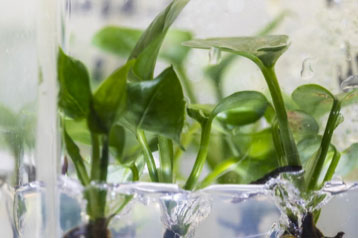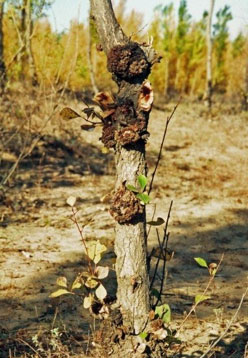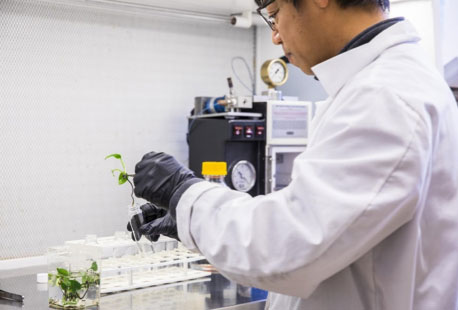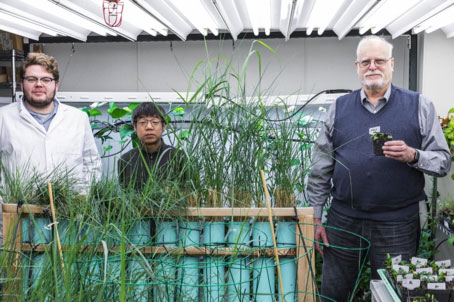| |
Highlights
- Benzene and chloroform are common toxins found in the air of your home. Neither chemical can be removed by air filters currently on the market.
- These researchers used the houseplant called pothos ivy (Epipremnum aureum) to detoxify the air by removing the pollutants benzene and chloroform. This was accomplished by genetically modifying these plants to contain the enzyme, cytochrome P450 2e1.
- The genetically modified houseplants reduced the concentration of both benzene and chloroform in the air. Benzene decreased in the test tube air by 75% after 8 days and chloroform dropped by 82% after 3 days.
Air is invisible, but that doesn’t mean it’s harmless. In addition to the oxygen we breathe in and the carbon dioxide we breathe out, air can carry many different types of molecules, and some of them can be toxic. It is possible to trap some of these toxins in air filters and to reduce the emissions of others. However, in the modern urban or suburban home, you can still expect to find toxins in the air. New research by Drs. Stuart Strand, Long Zhang, and colleagues in the Department of Civil and Environmental Engineering at the University of Washington in Seattle, Washington, proposes a novel solution to help clean up our home air: genetically modified houseplants that can reduce or remove some of the thorniest home air toxins.
Many people are surprised to learn that the air we breathe could be so dirty. That’s because many toxins in the air have no smell and are invisible to the naked eye. One of the biggest offenders is a chemical called
benzene,
which is also one of the most widely used chemicals in the United States. Benzene is used in the production of plastics and other household items. It is found in cigarette smoke and in gasoline. You could have benzene in your home if anyone in the home smokes, if you have a car in an attached garage, or if you keep fuel for the grill or lawnmower near your house.
Another common toxin found in the air is
chloroform.
Chloroform is formed through a process that occurs when chlorine combines with trace natural organic molecules found in water. Chlorine is typically added to water because it is very reactive and kills bacteria that cause disease. All water contains some organic molecules. When chlorine comes into contact with these trace organic molecules, chloroform is produced. Chloroform is not harmful when dissolved in water, but when the water is heated, chloroform is released into the air. Thus, you can be exposed to chloroform in the house when you take a hot shower, run the dishwasher with hot water, or cook.
Neither benzene nor chloroform can be removed by air filters currently on the market. That’s why Drs. Strand and Zhang set out to develop a different approach to these toxins: plants. Plants have been studied over the past few decades for their ability to transform air pollutants. These studies have had mixed results, however, in large part because an excessive number of plants would be required to significantly reduce the rates of toxins in the air.
Drs. Strand and Zhang tried a different approach to plants. They focused on a protein called cytochrome P450 2e1, or just 2e1 for short. This enzyme is present in all mammals, including humans, and it functions in our bodies to convert benzene into a less toxic molecule called
phenol
and to convert chloroform into carbon dioxide and chlorine. In humans, 2e1 is found mainly in the liver, making it ineffective for addressing air quality. Dr. Strand and his team wondered whether they could harness the detoxifying power of 2e1 outside of the human body—in plants.
Before they could act on this idea, Drs. Strand and Zhang had to figure out which plant species to use to test their hypothesis. They decided to focus on houseplants because they were small, lightweight, and could be found within the home. Specifically, the researchers chose the plant called pothos ivy (Epipremnum aureum) because it reproduces relatively quickly and grows well in all types of climates.

Figure 1. Researchers at the University of Washington have genetically modified a common houseplant - pothos ivy - to remove chloroform and benzene from the air.
[Credit: Mark Stone/University of Washington]
To test out their idea, Drs. Strand and Zhang used a technique called
Agrobacterium-mediated plant transformation,
a method commonly used to genetically modify plants. This technique works by harnessing the infectious power of the class of bacteria known as
agrobacterium.
These bacteria infect plants by inserting parts of their genetic material into the host plant cells. The genetic material from the bacteria causes the plant to make the type of sugar that feeds the bacteria rather than the plant. The bacteria grow and grow until the plant or tree eventually ruptures, releasing all the bacteria to find new hosts. You can see these infections as irregular rough bulges on the trunks of trees, called
galls.
Scientists removed the disease-causing parts of the Agrobacterium so that it can be used as a tool for inserting desirable genes such as those that destroy pollutants.

Figure 2. Galls on a tree.
[Source: Manfred Mielke, U.S. Department of Agriculture Forest Service, Bugwood.org]
Scientists can utilize agrobacteria to genetically modify plants by first altering the bacteria so that they insert the gene the scientists want. Dr. Strand and his team wanted to insert the 2e1 gene, so they added this gene to the agrobacteria. Specifically, they used the 2e1 gene found in rabbits. To select for the plants that contained 2e1, they also added a gene that makes the plants resistant to an antibiotic called hygromycin. As they grew, the little genetically modified plants would be exposed to the antibiotic hygromycin, which would kill the regular pothos ivy plant that did not take up the genes. However, if the plant was resistant to hygromycin because of the inserted gene, it would not die, demonstrating that the genetic modification with 2e1 had worked.
In addition to preparing the agrobacteria, Drs. Strand and Zhang also had to prepare the pothos ivy plants. The researchers began with pothos ivy plants they bought from the store. These plants could be contaminated, so they were not ideal for the researchers to use. Instead, they took samples of the stem from the store-bought plants, cleaned and sterilized them, and then let the plants grow in test tubes. It took between one and two months for these sterilized plant stems to grow roots and leaves. At this point, the sterilized plants were ready for modification with agrobacteria.
Drs. Strand and Zhang followed a strict procedure for the genetic modification of pothos ivy by agrobacteria. The sterilized pothos ivy plants were exposed to agrobacteria for 20 minutes, then sterilized, transferred, and allowed to grow for several more months. Once sufficiently grown, the potentially modified plants were exposed to the antibiotic hygromycin to allow only the genetically modified plants to grow and to confirm that the modification had worked.
This process was all about trial and error. Genetic modification by agrobacteria is a random process, meaning that the new pieces of genetic information could be inserted anywhere in the plant’s genome. If it was inserted in the middle of a gene critical to the regular functioning of the plant, then that plant would not survive. “We had to be very patient with this whole process,” Dr. Strand reflected.
Once the pothos ivy plants had been modified, it was time to test how well they performed at reducing the quantity of benzene and chloroform in the air. For these experiments, genetically modified plants were put in glass test tubes. They were compared to regular pothos ivy plants as well as empty test tubes to control for differences due to anything other than the genetic modification of the pothos ivy plant. The three types of test tubes were then exposed to either benzene or chloroform.

Figure 3. Dr. Long Zhang, a research scientist in the UW's civil and environmental engineering department, puts a pothos ivy plant into a glass tube to test its ability to break down benzene or chloroform.
[Credit: Mark Stone/University of Washington]
The air quality was tested by removing a small sample of air from each test tube with a syringe. The air was then analyzed using a machine called a
gas chromatograph
that identifies the components of the air, showing the researchers exactly how much pollutant was contained in the sample. They then tracked the change in pollutant levels over time, taking one sample per day over a period of eight days.

Figure 4. Picture of a gas chromatograph
Dr. Strand and his team achieved remarkable results. In the test tubes with genetically modified plants exposed to chloroform, the concentration of chloroform in the test tube air dropped by 82% after 3 days and was almost gone by day 6. For benzene, the concentration in the test tube air dropped by 75% after 8 days. “We were just amazed by the air quality these plants produced,” recalled Dr. Strand.
In future experiments, Dr. Strand and his team want to try to make these houseplants more effective by adding an additional enzyme that would break down another common household toxin called
formaldehyde.
Formaldehyde is commonly used in many industries including agriculture, construction, and manufacturing. In the home, formaldehyde can be found in wood products, some plastics, and is formed during cooking.
Where do these toxins go once they are absorbed by the plants? Formaldehyde and chloroform are completely degraded, broken into their component parts and utilized in the normal processing of the cell, ultimately released as oxygen and water. It has not been scientifically documented yet, but Dr. Strand believes that benzene also gets utilized by the plant. Just as in the human body, benzene is converted into phenol, and then, Dr. Strand believes, the phenol is used in plant metabolism.
Dr. Strand is hopeful that in the next few years these genetically modified pothos ivy houseplants will be available for sale, to be used at home to detoxify the air we breathe. The plants have already been approved for sale in Canada, and Dr. Strand hopes that in the next few years other countries including the United States will approve the plants.
Dr. Stuart Strand is a Research Professor in the Department of Civil and Environmental Engineering at the University of Washington. His research focuses on using plants to solve environmental problems. Dr. Strand began his career with an interest in the bacterial degradation of toxic compounds, especially in sewage processing. More recently his work focuses on novel solutions to water and air pollution. When not in the laboratory, Dr. Strand enjoys cooking, biking, and spending time with his family.
Dr. Long Zhang is a Research Scientist in the Department of Civil and Environmental Engineering at the University of Washington. His research focuses on plant science, bioengineering, and molecular biology. Now he works on degradation of toxic organic compounds in water and air with genetic modified plants. Dr. Zhang’s hobbies include soccer, gardening, hiking, and fishing.
For More Information:
- Zhang, L., R. Routsong, and S. Strand. 2018. “Greatly enhanced removal of Volatile Organic Carcinogens by a genetically modified houseplant, Pothos Ivy (Epipremnum aureum) expressing the mammalian cytochrome P450 2e1 gene.” Environmental Science and Technology, 53(1): 325-331.
To Learn More:
- Stuart Strand laboratory. https://faculty.washington.edu/sstrand/about.html
- United States Environmental Protection Agency. https://www.epa.gov/indoor-air-quality-iaq/improving-indoor-air-quality
- American Lung Association. https://www.lung.org/our-initiatives/healthy-air/indoor/at-home/
- National Institute for Occupational Safety and Health. https://www.cdc.gov/niosh/topics/indoorenv/default.html
- World Health Organization. https://www.who.int/airpollution/household/pollutants/en/
- Cytochrome P450. https://ghr.nlm.nih.gov/primer/genefamily/cytochromep450
- Facts about benzene. https://emergency.cdc.gov/agent/benzene/basics/facts.asp
- Does choloroform really knock you out as quickly as they show in the movies? https://www.scienceabc.com/humans/movies/does-chloroform-knock-you-out-as-quickly-as-they-show-in-movies.html
- Air Quality. https://airnow.gov/
Written by Rebecca Kranz with Andrea Gwosdow, PhD at www.gwosdow.com
HOME | ABOUT | ARCHIVES | TEACHERS | LINKS | CONTACT
All content on this site is © Massachusetts
Society for Medical Research or others. Please read our copyright
statement — it is important. |
|
|

The team behind the modified houseplants. From left to right: Ryan Routsong, Long Zhang, Stuart Strand. [Credit: Mark Stone/University of Washington]
Sign Up for our Monthly Announcement!
...or  subscribe to all of our stories! subscribe to all of our stories!

What A Year! is a project of the Massachusetts
Society for Medical Research.
|
|

